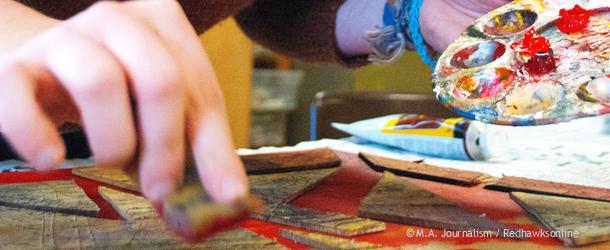Arts editor Jeffrey Riley considers whether artists need to include a message in their work
Ignoring the influx of vibrant, eye-catching colors and imaginative arrangement of media that flood the gathering area outside Minnehaha Academy’s very own Hognander Chapel seems to be impossible this time of year. As the AP Studio Art students wrap up the year, they are given the opportunity to exhibit a year’s worth of expression.
In lieu of an objective written exam, the College Board states that the students must complete a portfolio with the intention of “shar[ing] a basic, three-section structure, which requires the student to show a fundamental competence and range of understanding in visual concerns.”
Luckily for the Redhawk family, both peers and administration alike, these portfolios are submitted primarily through digital images, leaving the bulk of the originals in the artist’s possession. This art is on display outside the chapel, sustaining reputation of nurturing and encouraging souls to follows their artistic ambitions.
Passers-by may be struck by the latent visual talent that seems to emerge only once or twice a year and, without a doubt, feel overwhelmed by the expression. The converse is also possible for many students perplexed by how paint splattered on a canvas can be considered “art.”
Not exclusive to this exhibition of student work, but other displays of artwork elicit question from the inexperienced viewer. Whether strikingly detailed or beautifully abstract, sensibly relatable or startlingly unconventional, inquiries arise such as “what does this mean?” and “why is this art?”
The implications and intentions of any given artwork may appear incredibly subjective, leading to the rational yet cliché concept that “beauty is in the eye of the beholder.” Should the impression left on the proverbial “beholder” end here, or is there an underlying message needing to be sought after?
“Not all of my pieces have a message,” said senior AP Studio Art student Madison Cowmeadow. “But I find I like the ones that do much more. They turn out better when I start with something in mind.”
The nature of the AP Studio Art class revolves around the twelve pieces that make up the students concentration portfolio. This group of art is accompanied by a statement explaining the over-arching theme in the work or the intent of the artist.
“I like to send a political message in my artwork,” Senior Adam Schiffman. Schiffman created his work with an explicit message in mind and effectively conveyed that to those that see his work, basing his concentration around the idea of society’s role in stifling creativity.
Not all artists pursue such an explicit route of conveying their message. “Some artists resist saying anything or create work that is difficult to understand,” said art teacher Nathan Stromberg. “They are successful when the message comes across in some form.”
This style can be exemplified in the more abstract forms of art. When brush strokes on a canvas or carefully placed stones in a mosaic create an unfamiliar picture, deciphering a message may prove futile if that is not the intent of the artist.
“[Abstract art] is successful when a really beautiful abstract painting touches you and you feel it,” said Stromberg. “The viewer is exploring very unique feelings in abstract art.”
While the subjectivity in art may frustrate some, the responsibility of the viewer is a healthy combination of attempting to understand the artists intentions along with merely understanding the personal feelings and responses elicited by the pieces.

